

The Reading Identity Challenge. At the beginning of the year, I asked my students to tell me how they felt about reading.
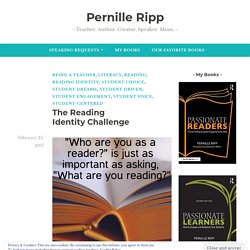
I do this every year as it offers me a baseline, a glimpse into their reading truths. I was not surprised at the results, 25% told me they loved it, 50% told me they didn’t mind it, and the final 25%? They told me they hated it. Perhaps slightly higher than normal, but nevertheless, teaching 7th graders, I was not worried. After all, every year it seems this happens and every year, children change their minds. This year, though, some have proven to be stubborn. So I created the Student Reading Identity Challenge.
A reading challenge for us all, so we all could get better, whatever better meant to us. We started with this five-page survey; yes, five pages. The goals varied; I want to enjoy reading again, I want to try a new genre, I want to read every day. The 7th Grade Reading Challenge. 33% of my 118 7th graders told me they had not read a single book last summer.
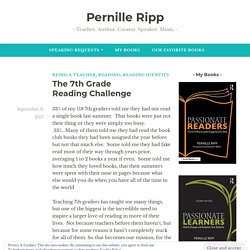
That books were just not their thing or they were simply too busy. 33%…Many of them told me they had read the book club books they had been assigned the year before but not that much else. Some told me they had fake read most of their way through years prior, averaging 1 to 2 books a year if even. Some told me how much they loved books, that their summers were spent with their nose in pages because what else would you do when you have all of the time in the world Teaching 7th graders has taught me many things, but one of the biggest is the incredible need to inspire a larger love of reading in more of their lives. Not because teachers before them haven’t, but because for some reason it hasn’t completely stuck for all of them.
What Happens When the Librarian Doesn’t Want to Read? When I meet new people, and the conversation turns to what I do for work, I invariably get the same sort of response.
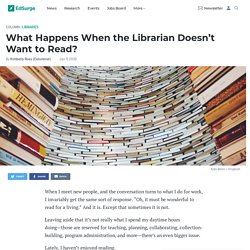
“Oh, it must be wonderful to read for a living.” And it is. Except that sometimes it is not. Leaving aside that it’s not really what I spend my daytime hours doing—those are reserved for teaching, planning, collaborating, collection-building, program administration, and more—there’s an even bigger issue. What Happens When the Librarian Doesn’t Want to Read? COVID-19 Is Forever Changing How Students Experience Libraries.
There’s a ritual that kicks off every new quarter in Michelle Luhtala’s library at New Canaan High School, one where English teachers send a gaggle of students through her doors to pick a new batch of books.

It looked different when the campus reopened in mid-October, when she had students select their books through an online portal to be delivered to their classrooms the next day. A case of being the same? Australia and New Zealand’s reading in focus - Megan C. Chamberlain, Emma J. Medina, 2020. Introduction The Organisation for Economic Co-operation and Development’s (OECD) Programme for International Student Assessment (PISA) started in 2000 with the aim of evaluating countries’ education systems by assessing 15-year-olds’ skills and knowledge in three key domains: reading, mathematical, and scientific literacies.
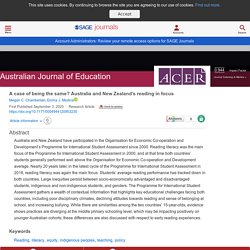
Focusing primarily on PISA 2018, the purpose of this paper is to compare and contrast the reading literacy results and key background factors for Australia and New Zealand’s students, also taking into account each country’s educational policy context. Background. Australian literature’s great silence. We believe in the free flow of information.
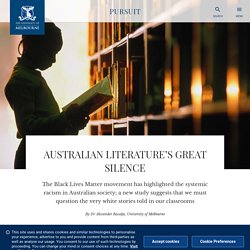
This work is licensed under a Creative Commons Attribution-No Derivatives 3.0 Australia (CC BY-ND 3.0 AU), so you can republish our articles for free, online or in print. All republished articles must be attributed in the following way and contain links to both the site and original article: “This article was first published on Pursuit. Read the original article.” <header><h1>Australian literature’s great silence</h1><p><a rel="author" href=" Alexander Bacalja</a> and <a rel="author" href=" Lauren Bliss</a></p></header><p>The <a href=" Lives Matter protests</a> have drawn attention to issues of race in Australia.
Little known Picture Books by Harry Reade – BOOK ILLUSTRATION ART. Harry Reade (1927-1998) was a character.
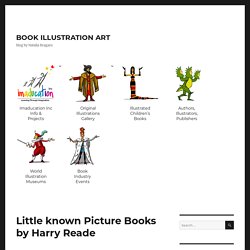
An ardent Australian communist who was a journalist, a seaman, a truck driver, kangaroo shooter, fisherman, political activist, comedian, film director, cartoonist, animation artist, illustrator, photographer, play writer. He spent ten years in Cuba advancing the cause of the Socialist Revolution, there he met and married a Russian beauty, who he followed to communist Soviet Union, where he engaged in illustrating political and satirical magazines and children’s books.[1][2] He also happened to author and illustrate a few hardly known but wonderful picture books, one of which is reviewed below. Harry Reade was born in Australia just before the Great Depression of the 1930’s.
Abandoned by his mother at the age of four he spent ten years on the road with his unemployed but politically active communist father. Koorie English Online. Page Content These modules have been developed for teachers in early childhood, primary and secondary school settings.
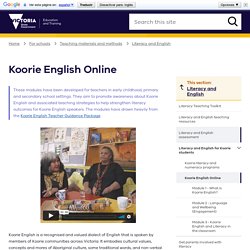
They aim to promote awareness about Koorie English and associated teaching strategies to help strengthen literacy outcomes for Koorie English speakers. The modules have drawn heavily from the Koorie English Teacher Guidance Package . 50 words project — Research Unit for Indigenous Language. This project aims to provide fifty words in every Indigenous language of Australia.
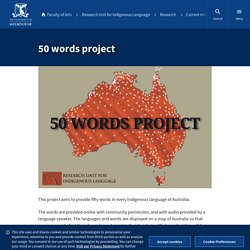
The words are provided online with community permission, and with audio provided by a language speaker. The languages and words are displayed on a map of Australia so that users can easily find the information relevant to their local area. We hope that this will be a useful resource for schools and educational organisations to learn 50 words in their local language, and for the general public to discover and appreciate the diversity of First Nations' languages around Australia. View the 50 words interactive language map. Aboriginal and Torres Strait Islander School Curricula. Dark sparklers : Yidumduma's Wardaman Aboriginal astronomy night skies Northern Australia / written ... Aboriginal and Torres Strait Islander School Curricula.
BUKU-LARRŊGAY MULKA CENTRE. BUKU-LARRŊGAY MULKA CENTRE. Indigenous Weather Knowledge. Aboriginal and Torres Strait Islander people have developed an intricate understanding of the environment over many thousands of years.

Artist: Laurie Nilsen The artwork used in the design of this website represents the relationships between seasonal, meteorological and astronomical changes - and how the Mandandanji people read these changes to inform life on country. About the Indigenous Weather Knowledge website Learn more about the Indigenous Weather Knowledge (IWK) website and the Bureau of Meteorology's commitment to strengthening respectful and collaborative relationships with Aboriginal and Torres Strait Islander people. About the Indigenous Weather Knowledge website Language, culture and environmental knowledge See an overview of the relationships between language, culture and environmental knowledge. Navigating our future through literature - Big Ideas - ABC Radio National. 2020 has brought with it fires, floods, protests and a pandemic. Enough for adults to bear, more than enough for younger generations. And while lockdown and online schooling has challenged the engagement of students, syllabus subjects need to be more nimble to reflect the world around us.
Australian literature can help us to better understand ourselves, and our relationships with our region and the world. Can we get over our cultural cringe enough to teach more relevant literature to help students navigate their future? This is a Melbourne Writers Festival event, in partnership with the Faculty of Arts at Melbourne University, recorded on 13 August 2020 Speakers. Our Land, Our Stories. Our Land, Our Stories. ATSILIRN - Aboriginal and Torres Strait Islander Library and Information Resource Network. 6. Secret and sacred materials There is information that is restricted, that our children cannot learn about, there is information that is restricted even to adults, there is information that is of a secret or sacred nature, that many people have no knowledge of or access to.
That knowledge is only there for certain people to have access to. ATSILIRN - Aboriginal and Torres Strait Islander Library and Information Resource Network. Selecting Indigenous resources. Deadly Questions – You ask. Aboriginal Victorians Answer. Teaching Aboriginal and Torres Strait Islander culture. Teachers must follow protocols for teaching Aboriginal and Torres Strait Islander culture. These are known as the Koorie Cross-Curricular Protocols. The protocols seek to protect the integrity of Aboriginal and Torres Strait Islander cultural expressions in a way in which all Australians can engage respectfully and feel connected to this identity. Koorie peoples.
Books. Australian. Building an inclusive collection. When choosing resources for your library’s Māori collection, look for publications in te reo Māori, as well as in the English language about Māori. Try to source materials for each section of your collection, including non-fiction and reference, fiction, picture books and graphic novels, magazines, newspapers and games. Include topics or narratives such as: biographies of Māori people tribal history and pre-European New Zealand history history written from a Māori perspective the Treaty of Waitangi and the Waitangi Tribunal stories by Māori authors or featuring Māori characters or stories told from a Māori perspective articles and stories featuring Māori contemporary life, experiences, and success.
Aboriginal and Torres Strait Islander education. Home – Australian Indigenous Astronomy. Growing Up Aboriginal in Australia by Anita Heiss. ‘Growing Up Aboriginal in Australia is a mosaic, its more than 50 tiles – short personal essays with unique patterns, shapes, colours and textures – coming together to form a powerful portrait of resilience.’ —The Saturday Paper ‘... provides a diverse snapshot of Indigenous Australia from a much-needed Aboriginal perspective.’ —The Saturday Age. Welcome to Country youth edition by Marcia Langton. Watch Spread the Word: Ngarrarndirrarjena and Access Teaching Resources. Convincing ground : learning to fall in love with your country / Bruce Pascoe. Nyernila - Culture Victoria. This story is based on the unique publication Nyernila – Listen Continuously: Aboriginal Creation Stories of Victoria. Aboriginal and Torres Strait Islander School Curricula. Books. Skip to the navigationSkip to content We respectfully caution Aboriginal and Torres Strait Islander readers that this website contains images of people who have passed away.
Close. Deadly Diseases by Janey Levy - 9781538239629 - Dymocks. Due to delays with some suppliers, some online deliveries are taking a little longer than usual. Please continue to track your delivery via the link provided. 100 Must-Read Classic Books, As Chosen By Our Readers.
Books. Copyright. Covid Crafts. Curation and Bibliographic tools. Displays. Education. Free Resources. General Library. LibGuides. Library Blogs. Library Ideas. Library Policy. Library Programs. Library strategic plans. Literacy. MISC. Reading Programs and related articles. Reading. Referencing. RE Resources. Role of TL. Social Justice. Twelfth Night by William Shakespeare.